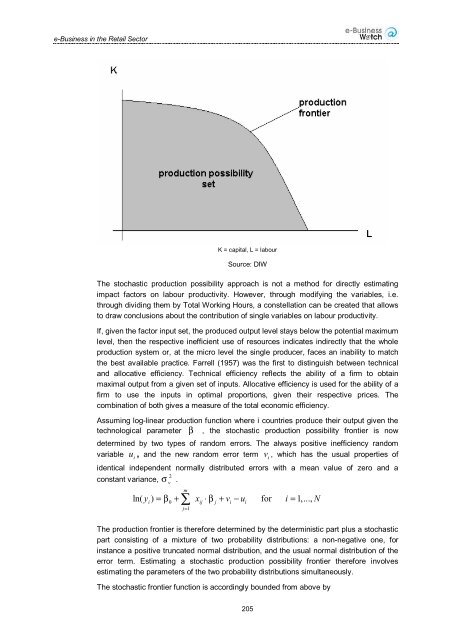ICT and e-Business Impact in the Retail Industry - empirica
ICT and e-Business Impact in the Retail Industry - empirica
ICT and e-Business Impact in the Retail Industry - empirica
- No tags were found...
Create successful ePaper yourself
Turn your PDF publications into a flip-book with our unique Google optimized e-Paper software.
e-<strong>Bus<strong>in</strong>ess</strong> <strong>in</strong> <strong>the</strong> <strong>Retail</strong> SectorK = capital, L = labourSource: DIWThe stochastic production possibility approach is not a method for directly estimat<strong>in</strong>gimpact factors on labour productivity. However, through modify<strong>in</strong>g <strong>the</strong> variables, i.e.through divid<strong>in</strong>g <strong>the</strong>m by Total Work<strong>in</strong>g Hours, a constellation can be created that allowsto draw conclusions about <strong>the</strong> contribution of s<strong>in</strong>gle variables on labour productivity.If, given <strong>the</strong> factor <strong>in</strong>put set, <strong>the</strong> produced output level stays below <strong>the</strong> potential maximumlevel, <strong>the</strong>n <strong>the</strong> respective <strong>in</strong>efficient use of resources <strong>in</strong>dicates <strong>in</strong>directly that <strong>the</strong> wholeproduction system or, at <strong>the</strong> micro level <strong>the</strong> s<strong>in</strong>gle producer, faces an <strong>in</strong>ability to match<strong>the</strong> best available practice. Farrell (1957) was <strong>the</strong> first to dist<strong>in</strong>guish between technical<strong>and</strong> allocative efficiency. Technical efficiency reflects <strong>the</strong> ability of a firm to obta<strong>in</strong>maximal output from a given set of <strong>in</strong>puts. Allocative efficiency is used for <strong>the</strong> ability of afirm to use <strong>the</strong> <strong>in</strong>puts <strong>in</strong> optimal proportions, given <strong>the</strong>ir respective prices. Thecomb<strong>in</strong>ation of both gives a measure of <strong>the</strong> total economic efficiency.Assum<strong>in</strong>g log-l<strong>in</strong>ear production function where i countries produce <strong>the</strong>ir output given <strong>the</strong>technological parameter β , <strong>the</strong> stochastic production possibility frontier is nowdeterm<strong>in</strong>ed by two types of r<strong>and</strong>om errors. The always positive <strong>in</strong>efficiency r<strong>and</strong>omvariable u , <strong>and</strong> <strong>the</strong> new r<strong>and</strong>om error term v , which has <strong>the</strong> usual properties ofiidentical <strong>in</strong>dependent normally distributed errors with a mean value of zero <strong>and</strong> aconstant variance, σ .2vm∑ln( y ) = β + x ⋅ β + v − u for i = 1,..., Ni 0ij j i ij=1iThe production frontier is <strong>the</strong>refore determ<strong>in</strong>ed by <strong>the</strong> determ<strong>in</strong>istic part plus a stochasticpart consist<strong>in</strong>g of a mixture of two probability distributions: a non-negative one, for<strong>in</strong>stance a positive truncated normal distribution, <strong>and</strong> <strong>the</strong> usual normal distribution of <strong>the</strong>error term. Estimat<strong>in</strong>g a stochastic production possibility frontier <strong>the</strong>refore <strong>in</strong>volvesestimat<strong>in</strong>g <strong>the</strong> parameters of <strong>the</strong> two probability distributions simultaneously.The stochastic frontier function is accord<strong>in</strong>gly bounded from above by205
















